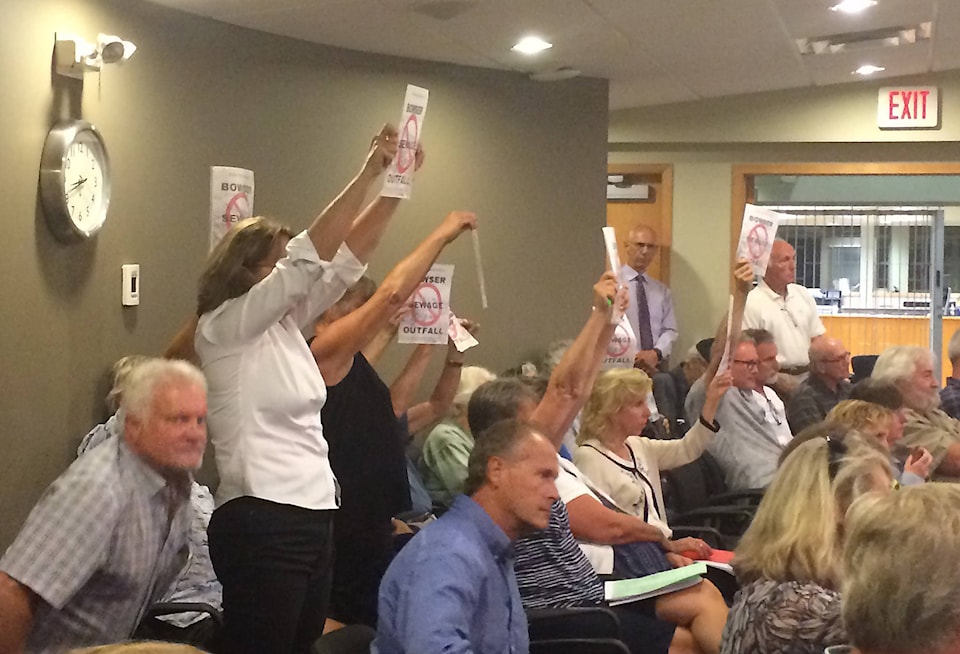The Regional District of Nanaimo board of directors has approved the Bowser Village Centre Wastewater Project.
Despite hearing the passionate pleas of Bowser residents and those from neighbouring communities at its regular meeting Tuesday, Aug. 22, the board unanimously adopted all three necessary bylaws — sewer service establishment, loan authorization and development cost charge — that will now provide the funding needed for the project to proceed.
Prior to Tuesday night’s board decision, the 99 property owners, representing 107 parcels in the proposed sewer service area, also voted in favour of the project via a petition process earlier this month. Out of the 107 parcels, 62.6 per cent, or 67 property owners, endorsed the $10.7 million project.
The board acknowledged its decision may not be a popular one, but it did not want to lose the $7.6 million Clean Water and Wastewater Fund, which most directors said was difficult to attain. The RDN is on a tight timeline, as the CWWF requires them to complete the project by March 31, 2019.
Seven individuals appeared before the board to express their strong opposition to the project, particularly the marine outfall option that will see treated sewage discharged to the sea through pipes laid in the residential Noonday Road public beach access site. They want the RDN to fully explore land disposal.
There were two delegations that wanted the project to proceed.
One resident, Thomas Gates, who is representing the Stop Bowser Marine Sewage Outfall group, presented the board with a petition with nearly 650 signatures. He strongly stressed that they are not opposed to the sustainable development of the village.
“The people that would be significantly impacted by the outfall are not the people who were given the vote,” said Gates. “No consultation was done with the impacted community. That’s just wrong. To be clear, of the over 3,800 citizens in Area H, only 107 votes were permitted. That means the proposed bylaw for an expandable service that will cause negative effect was voted on by less than three per cent of the population. This is not fair. This is not democratic. And it’s legally questionable.”
Gates indicated his group has hired legal counsel and, on Aug. 17, sent board chair Bill Veenhoff a letter from their solicitors.
“I trust that you shared the letter with the board,” said Gates. “The letter identifies the legal risks associated with nuisance and injurious affection which will be brought within a class action, again revealing an additional cost. Make no mistake, we will see this through in the end.”
Gates said there has been no study on best soil in areas identified in the Chatwin report in 2011, which he claimed was excluded by the RDN’s consultant, Stantec.
Veenhoff said the Bowser sewer project is an opportunity to achieve the vision of transforming Bowser into a small, compact community.
“The only way you can realize density in a small village is to have sewage treatment,” said Veenhoff. “That caused staff to ask for grants. It’s outstanding that we got the money. We have a plan in place to go forward. Tonight is just a step in the process. The very significant step happens after tonight.”
With the board’s approval, the RDN can now start detailed planning that will entail all aspects of the sewage system, including the outfall, said Veenhoff. It will also start the consultation process that will include the First Nations and other residents outside the village centre.
“I get the concerns about the outfall,” Veenhoff said prior to the board’s vote on the bylaws. “I understand that they are real and I understand that they have to be dealt with. People need to be listened to. The RDN is committed to having a public meeting with the residents of Area H and anybody else, I can imagine, to discuss the outfall. From those discussions that can only happen if we have a positive vote tonight, we will have a fulsome understanding of what is acceptable by the public in terms of an outfall. I would ask you very strongly to support this. It is the way forward. It is the way to realize the long-term aspirations of this board and the residents of Bowser and the village centre.”
Randy Alexander, general manager, regional and community utilities, was asked if the RDN, once the board approves the bylaw, could alter the location of the outfall. He indicated that the provincal government makes the final decision. All the components of the project will be reviewed by the province, including the detailed design of the sewage system and environmental assessments. It will also take into consideration the consultations conducted with residents and stakeholders.
“Ultimately it’s their decision whether it would be built or not, or relocated,” said Alexander.
The costs of the project not covered by the grant will be paid for by the developers and property owners.
The RDN will enter into a development cost charges (DCC) front-ender agreement with participating developers, A.G. Project Management Inc., Coral Ice Developments Ltd., Ballard Fine Homes Ltd., Magnolia Enterprises Ltd., and James Walter Foulds and Lenngy Austin Foulds.
They will cover $2.7 million, and the rest is to be shouldered by residents.
Story tips: michael.briones@pqbnews.com
